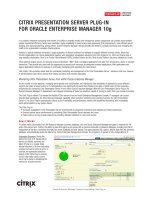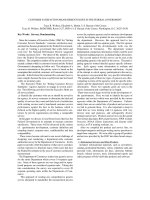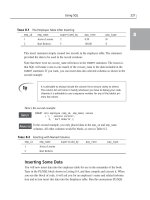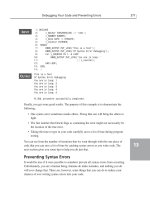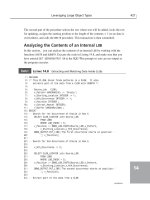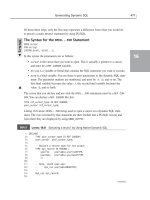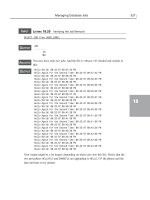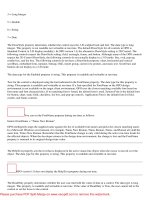Tài liệu Oracle Real Application Clusters in Oracle VM Environments doc
Bạn đang xem bản rút gọn của tài liệu. Xem và tải ngay bản đầy đủ của tài liệu tại đây (1.02 MB, 37 trang )
Oracle Real Application Clusters
in Oracle VM Environments
An Oracle Technical White Paper
March 2012
Oracle Real Application Clusters in Oracle VM Environments Page 2
Oracle Real Application Clusters
in Oracle VM Environments
Executive Summary 3
Introduction 4
What is Oracle Real Application Clusters (RAC)? 5
What is Oracle RAC One Node? 6
Why run Oracle RAC on Oracle VM? 8
Business Continuity, High Availability and Scalability 9
Live Migration and Online Database Relocation Support 11
When to use Live Migration or Oracle RAC One Node Relocation? 12
Deployment Methods 13
Hardware and Software Requirements 15
Oracle RAC on Oracle VM – Best Practices 19
Oracle Installation Recommendations 19
Generic Configuration Recommendations 19
Storage Configuration 20
Network Configuration 21
Sizing the Oracle VM Environment for Oracle RAC 23
Installing Oracle RAC in Oracle VM Environments 24
Use the Oracle RAC Oracle VM Templates 24
Live Migration and Database Relocation Best Practices 26
Summary 28
Appendix A – Guest Configuration File Example 29
Appendix B – Bonding Setup Example 30
Appendix C – References 34
Appendix D – Table of Figures 35
Appendix E – Known Limitations and Open Issues 36
Oracle Real Application Clusters in Oracle VM Environments Page 3
Oracle Real Application Clusters
in Oracle VM Environments
EXECUTIVE SUMMARY
Running today’s non-critical business applications in virtualized environments has
shown to be efficient and cost saving. More sophisticated or highly available
applications on the other hand were most likely incompatible with commonly used
software based virtualization solutions.
The availability of Oracle VM overcomes this obstacle. Providing software based
virtualization infrastructure (Oracle VM) and the market leading high availability
solution Oracle Real Application Clusters (RAC), Oracle now offers a highly
available, grid-ready virtualization solution for your data center, combining all the
benefits of a fully virtualized environment.
The combination of Oracle VM and Oracle RAC enables a better server
consolidation (RAC databases with underutilized CPU resources or peaky CPU
utilization can often benefit from consolidation with other workloads using server
virtualization) sub-capacity licensing, and rapid provisioning.
RAC on OVM also supports the creation of non-production virtual clusters on a
single physical server for product demos, educational settings and test
environments. This deployment combination permits dynamic changes to pre-
configured database resources for agile responses to changing service level
requirements common in consolidated environments.
Oracle VM is the only software based virtualization solution that is fully
supported and certified for Oracle Real Application Clusters.
This paper discusses various Oracle RAC deployment scenarios and provides best
practices for an optimized Oracle RAC deployment in Oracle VM environments
for Oracle VM versions 2.1.2 through Oracle VM 3.0.3. Version specific
information is noted accordingly.
Note: Oracle constantly tests additional, and advanced, Oracle VM features with
Oracle RAC. This paper is updated regularly as new test results are available.
Oracle VM and Oracle Real Application
Clusters (RAC) enable the benefits of a
virtualized data center infrastructure for
highly available applications.
Oracle Real Application Clusters in Oracle VM Environments Page 4
INTRODUCTION
Oracle Real Application Clusters (RAC)
1
is an option to the award-winning
Oracle Database Enterprise Edition. Oracle RAC is a cluster database with a shared
cache architecture that overcomes the limitations of traditional shared-nothing and
shared-disk approaches to provide highly scalable and available database solutions
for all your business applications. Oracle RAC is a key component of Oracle’s
enterprise grid architecture and cloud foundation.
Oracle RAC utilizes Oracle Clusterware
2
for cluster node and group membership,
high availability, and application resource management. Oracle Clusterware is the
technology that transforms a server farm into a cluster. A cluster in general is a
group of independent servers that cooperate as a single system. Oracle Clusterware
is the intelligence in this system that ensures the required cooperation and is a key
component of Oracle’s enterprise grid architecture as well as cloud foundation.
In a typical Oracle RAC installation, Oracle Automatic Storage Management
(ASM)
3
acts as the underlying, clustered volume manager. It provides the database
administrator with a simple storage management interface that is consistent across
all server and storage platforms. As a vertically integrated file system and volume
manager, purpose-built for Oracle database files, ASM provides the performance of
raw I/O with the easy management of a file system. Oracle Automatic Storage
Management provides the basis for a shared storage pool in Oracle’s enterprise grid
architecture and cloud foundation.
Oracle VM
4
is a platform that provides a fully equipped environment to better
leverage the benefits of virtualization technology. Oracle VM enables deployment
of operating systems and application software within a supported virtualization
environment. Oracle VM completes the Oracle’s enterprise grid offering by
providing an Oracle RAC certified virtualization environment.
1
Oracle Real Application Clusters (RAC) homepage:
2
For more information on Oracle Clusterware, visit
3
For more information on Oracle Automatic Storage Management (ASM), visit
4
Oracle VM homepage:
Oracle Real Application Clusters in Oracle VM Environments Page 5
WHAT IS ORACLE REAL APPLICATION CLUSTERS (RAC)?
A RAC Database is a clustered database. A cluster is a group of independent
servers that cooperate as a single system. Clusters provide improved fault resilience
and modular incremental system growth over single symmetric multi-processor
(SMP) systems. In the event of a system failure, clustering ensures the highest
availability to users and access to mission critical data is not lost. Redundant
hardware components, such as additional nodes, interconnects, and disks, allow the
cluster to provide high availability. Such redundant hardware architectures avoid
single points-of-failure and provide exceptional fault resilience.
Figure 1: Oracle Real Application Clusters Overview
With Oracle Real Application Clusters (as with any other Oracle database) the
Oracle Instance (the processes and memory structures allocated on a server to
allow access to the data) is de-coupled from the Oracle Database (the physical
structures residing on the storage, which actually hold the data. These structures are
commonly known as ‘datafiles’).
However, a clustered database (using more than one instance) differs from a single
instance database in a way that the database can be accessed by multiple instances
concurrently. Each instance runs on a separate server in the cluster (formed by
Oracle Clusterware).
When additional resources are required, additional nodes and instances can easily
be added to the cluster with no downtime. Once a new instance has been started,
applications using services can immediately take advantage of it with no changes to
the application or application server.
Oracle Real Application Clusters is an extension to the Oracle Database and
therefore benefits from the manageability, reliability, and security features built into
the Oracle Database.
Oracle RAC enables the Oracle Database
to run mainstream business applications
of all kinds on clusters, including popular
packaged products (such as Oracle
Ebusiness Suite, Peoplesoft, Siebel, SAP)
and in-house developed applications
generating OLTP, DSS, or mixed workload.
Oracle Real Application Clusters in Oracle VM Environments Page 6
WHAT IS ORACLE RAC ONE NODE?
Oracle Real Application Clusters (RAC) One Node
5
is a new option to the Oracle
Database 11g Release 2 Enterprise Edition. It improves upon many of the benefits
of server virtualization and extends them to databases running in physical server
environments. Oracle RAC One Node enables:
Better server consolidation
Enhanced protection from failures
Greater flexibility and workload management
Better online maintenance
In addition, it allows customers to virtualize database storage, standardize their
database environment, and, should the need arise, upgrade to a full multi-node
Oracle RAC database without downtime or disruption. Further, it is fully
compatible with and complementary to Oracle Virtual Machine (VM), allowing
customers to build environments that leverage the strengths of both Oracle RAC
One Node and server virtualization.
Figure 2: Oracle RAC One Node - typical architecture overview
In the configuration shown in figure 2, five single-instance Oracle RAC One Node
databases are running in a cluster of three servers. Server A is hosting Oracle RAC
One Node databases DB1 and DB2, server B is hosting database DB3 and server C
is hosting databases DB4 and DB5. Each server runs one OS. In servers A and C
above, multiple databases are consolidated onto a single OS.
5
For more information on Oracle RAC One Node see
Oracle Real Application Clusters in Oracle VM Environments Page 7
WHAT IS ORACLE VM?
Oracle VM
6
is a platform that provides a fully equipped environment for better
leveraging the benefits of virtualization technology. Oracle VM enables you to
deploy operating systems and application software within a supported virtualization
environment. The components of Oracle VM are:
Oracle VM Manager: Provides the user interface, which is a standard ADF
(Application Development Framework) web application, to manage
Oracle VM Servers
7
. Manages virtual machine lifecycle, including creating
virtual machines from installation media or from a virtual machine
template, deleting, powering off, uploading, deployment and live migration
of virtual machines. Manages resources, including ISO files, virtual
machine templates and sharable hard disks.
Oracle VM Server: A self-contained virtualization environment designed
to provide a lightweight, secure, server-based platform for running virtual
machines. Oracle VM Server is based upon an updated version of the
underlying Xen hypervisor technology, and includes Oracle VM Agent.
Oracle VM Agent: Installed with Oracle VM Server. It communicates with
Oracle VM Manager for management of virtual machines.
Figure 3: Oracle VM overview
6
Oracle VM homepage:
7
Oracle VM is also fully integrated into Oracle Enterprise Manager 10.2.0.5:
www.oracle.com/technology/software/products/oem/index.html
Oracle Real Application Clusters in Oracle VM Environments Page 8
WHY RUN ORACLE RAC ON ORACLE VM?
There are several reasons why customers may want to run Oracle RAC in an Oracle
VM environment. Some of the more common ones are:
1. Server Consolidation: Oracle RAC databases or Oracle RAC One Node
databases with underutilized CPU resources or variable CPU utilization
can often benefit from consolidation with other workloads using server
virtualization. A typical use case for this scenario would be the
consolidation of several Oracle databases (Oracle RAC, Oracle RAC One
Node or Oracle single instance databases) into a single Oracle RAC
database or multiple Oracle RAC databases where the hosting Oracle VM
guests have pre-defined resource limits configured for each VM guest.
2. Sub-capacity licensing: The current Oracle licensing model requires the
Oracle RAC database to be licensed for all CPUs on each server in the
cluster. Sometimes customers wish to use only a subset of the CPUs on
the server for a particular Oracle RAC database. Oracle VM can be
configured in such way that it is recognized as a hard partition. Hard
partitions allow customers to only license those CPUs used by the
partition instead of licensing all CPUs on the physical server. More
information on sub-capacity licensing using hard partitioning can be
found in the Oracle partitioning paper
8
. For more information on using
hard partitioning with Oracle VM refer to the “Hard Partitioning with
Oracle VM” white paper
9
.
3. Create a virtual cluster: Oracle VM enables the creation of a virtual
cluster on a single physical server. This use case is particularly interesting
for product demos, educational settings, and test environments. This
configuration should never be used to run production Oracle RAC
environments. The following are valid deployments for this use case:
a. Test / development cluster
b. Demo cluster
c. Education cluster
4. Rapid Provisioning: The provisioning time of a new application consists
of the server (physical or virtual) deployment time, and the software install
and configuration time. Oracle VM can help reduce the deployment time
for both of these components. Oracle VM supports the ability to create
deployment templates. These templates can then be used to rapidly
provision new (Oracle RAC) systems.
8
Oracle Licensing – Partitioning: www.oracle.com/corporate/pricing/partitioning.pdf
9
Hard Partitioning with Oracle VM -
www.oracle.com/technology/tech/virtualization/pdf/ovm-hardpart.pdf
Oracle Real Application Clusters in Oracle VM Environments Page 9
BUSINESS CONTINUITY, HIGH AVAILABILITY AND SCALABILITY
Business continuity is a key element in today’s business and while Oracle RAC is
still the ultimate solution when it comes to Oracle Databases, there are more
options to choose from when considering virtualization technologies.
Two different kinds of High Availability (HA) mechanisms can be distinguished in
an Oracle virtual environment: Oracle VM HA (external HA) and Oracle
Clusterware based, internal HA (used for Oracle RAC) as illustrated in figure 3.
Figure 4: Oracle VM HA and Oracle RAC
In general, Oracle VM HA enables the restart of an Oracle VM guest on either the
same physical machine or a different machine, if more than one physical machine is
available in the server pool. However, in any case, Oracle VM would operate on the
VM guest as a whole, restarting whatever is running within it.
The reason is that the Oracle VM guest is usually unaware of the applications
running in the virtualized environment as much as the application is typically
unaware of the Oracle VM guest it is running in.
For a fast, finer grained recovery from a process or application failure within an
Oracle VM guest, an internal, cluster based HA solution like Oracle Clusterware
(used for Oracle RAC) should be used. Utilizing application specific agents, these
solutions will perform corrective actions particular to the failure without the
overhead of restarting the whole Oracle VM guest
While a combination of both an internal application HA and the external VM HA
serves different HA functions, it needs to be noted that the Oracle VM HA and
Oracle VM policy-based resource management, Distributed Resource Scheduling,
(DRS) must not interfere with inherent Oracle RAC instance placement rules.
Oracle Real Application Clusters in Oracle VM Environments Page 10
Specifically, for mission-critical, production deployments it is unsupported to co-
locate Oracle VM guests hosting instances of the same Oracle RAC database on a
single OVS physical server as a result of Oracle VM guest failover or automated
DRS placement policy. Any Oracle VM guest failover or DRS placement policies
must respect this fundamental RAC instance placement rules.
Using Oracle VM HA for Oracle VM guests hosting an Oracle RAC
database is therefore not supported in OVM 2.2 and earlier versions. Starting
with Oracle VM 3.0.3 the following HA combinations are possible:
1. Oracle Real Application Clusters (RAC) High Availability and Scalability
a. Without additional Oracle VM guest HA
b. In conjunction with Oracle VM guest HA,
where Oracle RAC instance placement policies are respected.
2. Oracle Clusterware (failover cluster) provided High Availability
a. Without additional Oracle VM guest HA
b. In conjunction with Oracle VM guest HA,
where Oracle RAC instance placement policies are respected.
3. Standalone Oracle VM guest High Availability
for Oracle single instance databases for example.
Lately, some vendors of software based virtualization have announced that they will
provide better business continuity with “continuous availability” or “fault tolerant”
solutions that would be solely based on their virtualization software.
Those solutions might be suitable for lightweight, stateless applications, however,
they are not suitable for mission critical production databases. This means that for
production environments the choice is limited to the solutions listed above.
For Oracle RAC production environments, solution 1a (Oracle RAC HA and
scalability without additional Oracle VM guest HA) must be used, which still
provides the full Oracle RAC HA and scalability benefits. Please see Live Migration
support noted later in this paper.
However, for test systems and small development systems, i.e. non-production
environments, solution 1b (Oracle RAC HA and scalability in conjunction with
Oracle VM guest HA) can be used.
On the other end of the scale, solution 3 (Standalone Oracle VM guest High
Availability) is fully supported by Oracle. However, it is limited in its capability to
protect the actual application within the virtual environment. It will nevertheless
provide optimal protection against physical hardware failures.
Oracle Real Application Clusters in Oracle VM Environments Page 11
Solution 2 Oracle Clusterware [failover cluster] together with Oracle RAC One
Node might be an alternative when it comes to single instance databases or other
applications that need to be protected against hardware and process failures.
For Oracle Clusterware based solutions regardless of Oracle VM, the current
support status can be found in Oracle Metalink Note 790189.1 - Oracle
Clusterware and Application Failover Management. More information can be
found on
LIVE MIGRATION AND ONLINE DATABASE RELOCATION SUPPORT
Additional solutions that improve business continuity and availability for Oracle
RAC in an Oracle Virtual Machine environment include Oracle VM Live Migration
and Oracle RAC One Node Online Database Relocation
Oracle VM Live Migration moves a virtual machine from one physical node to
another, within the same pool of servers. Oracle RAC One Node Online Database
Relocation moves an Oracle database instance from one server to another within the
same cluster. In Oracle VM environments, these servers are virtual machines, which
host an Oracle Clusterware based cluster.
As of now, Oracle does not support mixed cluster environments, in which some
cluster members are based on virtual machines while others are based on physical
servers. Oracle RAC One Node Online Database Relocation can therefore not be
used to migrate between physical and virtual environments.
As pointed out above, Oracle VM HA cannot be applied to Oracle VM guests that
host an Oracle RAC cluster due to possible violations of Oracle RAC instance
placement rules and CPU allocation rules when automatically re-placing an Oracle
VM instance after a failure.
However, Oracle VM Live Migration offers a controlled mechanism for manually
moving Oracle VM guests between physical nodes in the server pool. Since Oracle
VM Live Migration allows for the relocation of an Oracle VM guest while respecting
the placement and CPU allocation rules for Oracle RAC, it can be applied to Oracle
VM guests that host an active Oracle RAC instance or instances.
Oracle Real Application Clusters in Oracle VM Environments Page 12
Figure 5: Live Migration and
RAC One Node Database Relocation illustrated
When to use Live Migration or Oracle RAC One Node Relocation?
Oracle VM Live Migration and Oracle RAC One Node Online Database
Relocation, together, offer complimentary solutions which support continuous,
non-interrupted High Availability for the Oracle database.
Live Migration of Oracle VMs offers operating system (OS) level migration to
facilitate workload management, fault management, and system maintenance
operations, for example, Live Migration permits server level maintenance while not
losing access to the Oracle RAC database VM.
Oracle Live Migration basically consists of iteratively pre-copying the contents of a
source VM’s memory from one physical host to another target VM on a remote
host with minimal interruption to service.
Oracle RAC One Node Online Database Relocation offers instance level migration
between properly configured VMs to facilitate maintenance and workload
management within VMs. Using Oracle RAC One Node Online Database
Relocation, the Oracle RAC One Node instance can be relocated to another server,
if the current server is resource constrained or requires maintenance operations
such as OS patches for example.
Oracle RAC One Node Online Database Relocation will also migrate Oracle RAC
One Node databases to target VMs to facilitate database maintenance on the source
VM without interruption of service to other database instances that may be running
in the source or target VM. A typical example for such an operation would be a
rolling patch upgrade for a database.
Oracle Real Application Clusters in Oracle VM Environments Page 13
DEPLOYMENT METHODS
Historically and typically, virtualized environments were ideal for development or
test environments. Easy to re-install by re-deploying a formerly saved base image
or template, once the current environment is ‘worn out’ by various test runs.
Oracle VM provides those benefits as part of the virtual cluster creation and the
rapid provisioning approach, even when used together with Oracle RAC, as
described in the previous section.
Figure 5 shows a typical Oracle RAC deployment for a development or test
environment based on Oracle VM. It should be noted that for virtual test or
development clusters Oracle allows having the 2 Oracle VM Guest Domains,
each hosting 1 Oracle RAC database instance, running on only 1 Oracle VM host.
Domain-0
Guest Domain 1
Database 1
Database 1
Instance 1
ASM Instance
+ASM2
ASM Instance
+ASM1
Database 1
Instance 2
Oracle ClusterWare
Oracle Enterprise Linux
Oracle ClusterWare
Oracle Enterprise Linux
Guest Domain 2
Figure 6: Oracle RAC on Oracle VM: Development Deployment example
Based on rigorous certification tests, Oracle has certified Oracle RAC on Oracle
VM for production environments from Oracle VM 2.1.2 through Oracle VM
3.0.3. This is the only certified software based virtualization technology for Oracle
Real Application Clusters and thereby enables these technologies to be used beyond
the scope of pure development or test environments.
Oracle VM is the ideal infrastructure for
Oracle RAC used in virtual development,
test, demo, or education clusters, based
on only one Oracle VM host.
Oracle Real Application Clusters in Oracle VM Environments Page 14
Unlike test and development environments, typical production environments
would use more than one Oracle VM host for each Oracle VM Guest Domain
(minimum 2), each, again, hosting an Oracle RAC database instance, as illustrated
in figure 6. These kinds of configurations are as well most likely used in server
consolidation environments.
Having more than one Oracle VM host as the underlying hardware platform to
host the Oracle VM Guest domains with the Oracle RAC database instances
eliminates the host hardware to be the single point of failure.
Domain-0
Guest Domain 1
Database 1
Instance 1
Database 2
Instance 1
Database 1
Instance 2
Database 2
Instance 2
ASM Instance
+ASM1
ASM Instance
+ASM1
ASM Instance
+ASM2
ASM Instance
+ASM2
Oracle ClusterWare
Oracle Enterprise Linux
Oracle ClusterWare
Oracle Enterprise Linux
Oracle ClusterWare
Oracle Enterprise Linux
Oracle ClusterWare
Oracle Enterprise Linux
Guest Domain 2
Domain-0
Guest Domain 1
Guest Domain 2
Database 1
Database 2
Figure 7: Oracle RAC on Oracle VM: Production Deployment example
Oracle VM together with Oracle RAC
enables fully virtualized environments as
the bases for server consolidation and
highly available applications. In order to
avoid a single point of failure, a minimum
of two Oracle VM hosts must be used for
production systems.
Oracle Real Application Clusters in Oracle VM Environments Page 15
HARDWARE AND SOFTWARE REQUIREMENTS
Oracle has certified Oracle RAC in Oracle VM environments based on the
following hardware and software requirements. Configurations that do not fulfill
these requirements are currently not supported.
Note: As a minimum, the hardware and software requirements listed in the Oracle
RAC documentation must be met to deploy Oracle RAC on Oracle VM in
production environments.
10
Note: Oracle is constantly in the process of testing additional and advanced Oracle
VM features with Oracle RAC. This paper will be updated regularly as new test
results are available.
Hardware requirements for Production Environments:
Minimum of 2 Oracle VM hosts are strongly recommended
o Each host must provide a minimum of 2 Ethernet NICs for
Oracle VM management and the Oracle RAC public and private
(interconnect) communication. A minimum of 4 Ethernet NICs
are required, if network based storage connectivity is used.
o 10GbE network interfaces are supported. It is recommended that
these NICs support IEEE Data Center Bridging standards.
o For the interconnect 1 Gbit Ethernet or 10GbE is required
Network redundancy requirements will double the number or NICs given
above accordingly. (4-6 NICs strongly recommended.)
Storage redundancy requirements will require a minimum of two HBAs or
SCSI controllers.
Hardware requirements for Development Environments:
For Development or non-production environments on a single Oracle VM
host, external storage is recommended, but not required.
Virtual network connectivity can be established within the
Oracle VM host, if no external client connects are required.
Oracle recommends using identical hardware configurations for
development and pre-production Q&A environments accurately modeling
production environments.
Oracle RAC Software
Oracle RAC and Oracle Clusterware 10.2.0.4, 11g Rel. 1, 11g Rel. 2
in 32-bit and 64-bit software versions are currently supported.
10
Oracle Real Application Clusters in Oracle VM Environments Page 16
General Oracle VM
Oracle VM release: 2.1.2 through Oracle VM release 3.0.3 are supported.
Older releases are not supported with Oracle RAC or Oracle Clusterware.
When using Oracle RAC:
o Dynamic vCPU and memory changes are not supported.
o Live Migration of an Oracle RAC VM is not supported with
Oracle VM releases earlier than 2.2.1
o Oracle RAC One Node (Online Database Relocation)
is supported with Oracle VM 2.1.5 and later and Oracle
Database 11g Rel. 2 (11.2.0.2) and later.
Oracle VM Guest Configuration
The guest must be a para-virtualized guest
Oracle Linux 5.1 or higher (OL 5.1 or higher)
32-bit and 64-bit Linux is currently supported for the Oracle VM Guest
Oracle VM Server release 3.0 requires 64-bit x86 hardware
Oracle VM vCPU configuration for Oracle RAC
Testing has shown that a small amount of incidental over-committing of physical
CPUs will not greatly diminish the overall stability of the system or the cluster stack
where the competing workloads for oversubscribed resources are well understood
and concurrent demand does not exceed physical capacity.
It is still recommended, however, not to over-commit CPUs. Multi-core CPUs
will treat every core as a virtual CPU (vCPU) and multi-core CPUs with multi-
thread support will treat each thread as a vCPU. vCPU allocation in Oracle
RAC / VM environments must therefore adhere to the following rules:
Maintain Oracle VM’s default vCPU allocation for dom-0:
Oracle VM will allocate 1 vCPU for each real CPU or core to dom-0.
The total amount of vCPUs allocated to guest domains (running
Oracle RAC guests), should not exceed two times (2x) the amount
of real CPUs / cores in the Oracle VM server.
The amount of vCPUs allocated to a single guest domain should not
exceed the amount of real CPUs / cores in the Oracle VM server.
CPU pinning is only recommended for hard partitioning. If no hard
partitioning is required, CPU pinning should not be used.
Oracle Real Application Clusters in Oracle VM Environments Page 17
vCPU allocation examples
Example 1: A server with 8 cores – 2 CPUs, quad core.
Valid configuration (CPUs are over-committed in accordance to the rules)
Dom-0 has 8 vCPUs allocated (default allocation)
Guest domain 1 (running RAC) has 8 vCPUs allocated
Guest domain 2 (running RAC) has 4 vCPUs allocated
Guest domain 3 (running RAC) has 2 vCPUs allocated
Guest domain 4 (running RAC) has 2 vCPUs allocated
Invalid configuration
Dom-0 has 4 vCPUs allocated (non-default allocation)
o Violation 1: non-default dom-0 vCPU allocation
Guest domain 1 (running RAC) has 10 vCPUs allocated
o Violation 2: allocated vCPUs (10) > real CPUs (8)
Guest domain 2 (running RAC) has 6 vCPUs allocated
Guest domain 3 (running RAC) has 8 vCPUs allocated
o Violation 3: Total allocated vCPUs (24) > 2x real CPUs (16)
Example 2: A server with 24 cores – 4 CPUs, 6-core
Valid configuration (CPUs are not over committed)
Dom-0 has 24 vCPUs allocated (default allocation)
Guest domain 1 (running RAC) has 12 vCPUs allocated
Guest domain 2 (running RAC) has 2 vCPUs allocated
Guest domain 3 (running RAC) has 4 vCPUs allocated
Guest domain 4 (running RAC) has 6 vCPUs allocated
Invalid configuration
Dom-0 has 32 vCPUs allocated (non-default allocation)
o Violation 1: non-default dom-0 vCPU allocation
Guest domain 1 (running RAC) has 28 vCPUs allocated
o Violation 2: allocated vCPUs (28) > real CPUs (24)
Guest domain 2 (not running RAC) has 8 vCPUs allocated
Guest domain 3 (running RAC) has 12 vCPUs allocated
Note: vCPUs are based on cores, not threads.
Single core CPUs are counted as 1 CPU.
Oracle Real Application Clusters in Oracle VM Environments Page 18
Oracle VM supported storage configurations for Oracle RAC
Oracle VM itself allows configuring storage in many different ways. Oracle RAC
and Oracle Clusterware are not supported on all possible storage configurations
that Oracle VM offers.
Figure 8: Storage configuration options in Oracle VM
Generally, storage configurations can be divided into two groups:
Dom-0 managed storage
In this method of storage configuration, the storage is made available in dom-0
and then made available in the guest domains using the guest’s configuration file.
Guest managed storage
In this method of storage configuration, the storage is made available directly in the
guest domain. It is not visible in dom-0.
Storage configuration method
Supported with Oracle RAC
Dom-0 managed storage
SAN / block device
Yes
iSCSI / block device
Yes
SAN / OCFS
No
iSCSI / OCFS
No
NFS
No
Guest managed storage
iSCSI
Yes
NFS
Yes
Table 1: Storage options supported with Oracle RAC
Oracle Real Application Clusters in Oracle VM Environments Page 19
ORACLE RAC ON ORACLE VM – BEST PRACTICES
Based on extensive tests in the course of the Oracle RAC for Oracle VM
certification, Oracle has developed some best practices recommendations in order
to run Oracle RAC in an optimized virtual environment. Below you will find some
of the recommendations as a result of those tests.
Note: Oracle continually tests additional and advanced Oracle VM features with
Oracle RAC. This paper is updated regularly as new test results are available.
Oracle Installation Recommendations
Setting diagwait in Oracle Clusterware
When running Oracle RAC in highly stressed clusters (CPU and memory bound),
Oracle recommends setting the diagwait to 13 seconds. This prevents false
evictions and enables a better diagnosis in case of false evictions.
When running Oracle RAC 10.2.0.4 or 11g Rel. 1 in Oracle VM environments, it is
strongly recommended to set diagwait to 13 seconds for all installations, regardless
of utilization. Before changing the diagwait value, please, review Metalink Note
559365.1 (Using Diagwait as a diagnostic to get more information for diagnosing
Oracle Clusterware Node evictions).
Note that with 11g Rel. 2 the diagwait setting has been internalized. Setting the
diagwait value is not required anymore.
Generic Configuration Recommendations
Time synchronization
By default, the Oracle VM Guest time is automatically synchronized with Domain-
0. This time synchronization can allow some time drift in the guest domains
running Oracle RAC. Therefore, the following recommendations should be
implemented when running Oracle RAC in Oracle VM:
Configure xen.independent_wallclock=1
in /etc/sysctl.conf in the guest domains only.
This allows the para-virtualized guests to manage their own system clocks.
Configure NTPD in dom-0
Configure NTPD with the –x flag in all the guest domains per Metalink
Note 1056693.1. See also Metalink Note 580296.1 (Clock drift issue
between Dom-0 and Dom-U on OVM Server) for more context.
Note that Oracle Grid Infrastructure 11g Rel. 2 provides the Oracle Cluster
Time Synchronization Service (CTSS) daemon, which can be used to synchronize
the time between cluster members if NTPD is not used in the VM Guests to
synchronize the time against an external time server.
Oracle Real Application Clusters in Oracle VM Environments Page 20
Storage Configuration
Multipathing and Device Persistency in Domain-0
For Oracle RAC in Oracle VM environments, multipathed access to the (SAN)
storage is highly recommended. Multipathing should be configured in Domain-0
and not in the guest domains. All supported multipathing tools can be used, e.g.
Device Mapper, QLogic multipathing, etc.
Device persistency, if not already configured as part of the multipathing solution
mentioned above, should also be set up in Domain-0. If the multipathing software
doesn’t offer device persistency, the Linux inherent udev configuration should be
used. There is no need to set up device persistency in the Guest VMs. The mapping
of Oracle VM disks to guest disks is done statically in the guest configuration file
(see Appendix A for an example).
Storage Configuration for the Oracle VM Guests hosting the Oracle RAC database
The only configuration that is required to be set up in the Oracle RAC guest
domains is the setup of the permissions on the block devices. In addition, when
running pre-Oracle RAC 11g Release 2, it may be required to configure RAW
devices. It is strongly recommended to use the Linux native udev tool to create the
RAW devices with the right permissions on the disks in the Oracle VM guest.
Oracle recommends using Oracle Automatic Storage Management (ASM) to
manage these RAW devices and as the underlying volume manager for the Oracle
RAC database files. Optionally, ASMLib can be used in the guest domains in order
to further simplify OS disk administration.
Note, as of 11gR2 raw devices are no longer supported for new RAC installs.
Figure 9: SAN Storage on Oracle VM
Oracle Real Application Clusters in Oracle VM Environments Page 21
Cluster file system requirements
Some applications require running the Oracle RAC database on a cluster file system
or relying on some files that need to be available on every node. For these
applications the Oracle ASM Cluster File System (ACFS – 11g Rel. 2 or later)
should be used in the guest domains.
Network Configuration
Required Networks
The Oracle VM host should have a sufficient number of NICs to provide at least
two distinct bridges and virtual NICs to the guest domains. For production systems
the number of NICs per Oracle VM host is specified in the “Hardware and
Software Requirements” section of this paper. The actual number of NICs depends
on the overall configuration and level of redundancy desired.
As for any other Oracle RAC configuration, a separation of networks for the
1. Public network
2. Private network (cluster interconnect)
3. Storage network (if applicable)
is required for production environments. Therefore, the Oracle VM host must
ensure that the respective communication would not interfere with each other.
These networks can be shared with multiple Oracle RAC VM Guests on an Oracle
VM host. However, network bandwidth and capacity must be considered in this
case (see “Sizing the Oracle VM environment for Oracle RAC” for
recommendations).
Network Bonding
For production environments it is strongly recommended to have two Network
Interface Controllers (NICs) for each network and use Linux bonding configured
in Dom0 to make them highly available. This results in an Oracle RAC network
HA requirement of a minimum of four NICs (for public and private network) per
Oracle VM host running Oracle RAC, as illustrated in figure 8. Appendix B
explains setting up bonding devices step-by-step.
For the Oracle Clusterware private interconnect, in place of Linux bonding in
Dom0, you may present two to four vNICs for the private interconnect to each of
the configured Oracle VM guests. Each vNIC would map to a distinct physical
network interface, either on a single subnet or multiple subnets for Oracle
clusterware interconnect high availability.
Oracle Real Application Clusters in Oracle VM Environments Page 22
This feature, Redundant Interconnect Usage
11
or HAIP is a layer 3 NIC
aggregation model managed by the Oracle Clusterware in each of the Oracle VM
guests and uses automatically assigned, non-routed link local addresses for the
Oracle RAC interconnect communication. An acceptable configuration would be a
combination of Linux bonding of the clusterware interconnects in Dom0 with
HAIP configured in the Oracle VM guests.
Figure 10: Full network bonding in Oracle VM
11
See Oracle® Clusterware Administration and Deployment Guide
11
g
Release 2 (11.2), Chapter 2, Administering Oracle Clusterware
Oracle Real Application Clusters in Oracle VM Environments Page 23
Sizing the Oracle VM Environment for Oracle RAC
As a general rule of thumb, you should “size your Oracle VM environment in a
similar way as you would size a non-VM environment.” Following this rule when
sizing an Oracle VM system Oracle RAC should cover most of the optimization.
Particular attention should be paid to the following parameters:
CPUs and cores
Follow the requirements as stated in this document for assigning vCPUs to dom-0
and guest domains. It is supported, but not recommended, to over-commit by a
factor of 2.
Memory
Memory is not shared between domains in Oracle VM. When sizing memory for
your Oracle RAC VM system, make sure your system memory is large enough to
accommodate the memory needed for Domain-0, the Linux Operating systems,
Oracle Clusterware, and the Oracle RAC databases in each of the guest domains.
Network
For an Oracle RAC in Oracle VM environments the general recommendation is to
install a minimum amount of 2 NICs per Oracle VM host machine. For a
production environment the recommendation is to have at least 4 network cards
installed in the host and use bonding.
Using a shared network bridge, bandwidth is shared between the different guest
domains installed on one Oracle VM server. In production environments, these
network interfaces must be at a minimum 1 Gbit Ethernet, for example 1000BASE,
however, 10GbE, 10GBASE is supported.
When configuring a larger number of guest VMs on one host, or when deploying
guest VMs that require a high amount of network bandwidth, conscientious
monitoring for oversubscription events resulting in packet loss, either on the NIC
or the switch, and/or increased latencies and bandwidth degradation must be
implemented.
Storage
When using SAN storage for your Oracle RAC in Oracle VM deployment, more
than one HBA can be used to use a higher bandwidth to the storage in the Oracle
VM host. The multipathing drivers usually combine the bandwidth of each path
automatically.
When using NAS storage (preferably using iSCSI), it is recommended to use a
dedicated network interface to access the NAS storage. The dedicated storage
network should be configured in the same way as the public or interconnect
network. Again, multiple NICs can be used to eliminate a single NIC as a Single-
Point-Of-Failure and appropriate bonding configurations can be used to increase
bandwidth.
Oracle Real Application Clusters in Oracle VM Environments Page 24
INSTALLING ORACLE RAC IN ORACLE VM ENVIRONMENTS
The following steps describe the complete installation of Oracle RAC in an Oracle
VM environment. Oracle recommends to use the Oracle RAC Oracle VM
templates for a rapid provisioning of Oracle RAC on Oracle VM.
1. Plan your installation carefully. Consider the requirements for your new
environment and plan accordingly using the guidelines and best practices
in this white paper and the official Oracle documentation.
2. Install the appropriate version of Oracle VM that you want to use (Oracle
VM 2.1.5 through 3.0.3 are supported) on the machine(s) on which you
want to perform the Oracle RAC installation. Follow the Oracle VM
Server Installation Guide for the details on how to do this.
3. From the Oracle VM Manager GUI, discover the servers and configure
storage and networking. When using the certified Oracle RAC templates,
time synchronization in Domain-0 of your Oracle VM host(s) is correctly
pre-configured. Otherwise, you will need to verify and correct it on each
server as required.
4. Create the para-virtualized guests domains for the Oracle RAC installation.
5. Install and configure the guest operating system (Oracle Linux 5.1 or
higher). Make all necessary configuration changes to the guest operating
system as described in the requirements for installing Oracle Clusterware
and Oracle RAC. Use udev to configure the raw devices required for
installing Oracle RAC. Optionally, ASMLib can be used in the guest
domains in order to further simplify OS disk administration.
6. Install Oracle Clusterware and Oracle RAC 10.2.0.4, 11g Rel. 1 or 11g Rel.
2 as for non-virtualized environments, following the installation guides for
these products. Consult My Oracle Support for more and up-to-date
information regarding the installation and certification of Oracle RAC on
specific Operating System versions.
USE THE ORACLE RAC ORACLE VM TEMPLATES
Using Oracle VM Oracle RAC templates provide an easy and fast way of deploying
an Oracle RAC cluster in Oracle VM for test as well as production
environments.
The 11g Rel. 1 based templates are designed to build a 2-node Oracle 11g Release 1
(11.1.0.7) RAC cluster, which includes an Oracle 11g Database, Oracle 11g
Clusterware, and Oracle 11g Automatic Storage Management (ASM). More nodes
can be added easily. The 11g Release 2 based templates allow for flexibility,
including the creation of N-node clusters and installations using role separation.
Oracle Real Application Clusters in Oracle VM Environments Page 25
The entire installation is automated, requesting minimal information (e.g. node
names, IP addresses, etc.) from the user when the first guest is booted at creation
time. The final cluster configuration adheres to the best practices for production
systems as described in this paper.
The current Oracle VM Oracle RAC templates are available supporting a variety of
Oracle Linux 5.x based system images for either 32-bit or 64-bit. The OS image
contains a minimal installation of Oracle Linux 5.x. Only basic RPM packages are
installed. Configuration and benefits at a glance:
The Oracle VM templates build a 2-node Oracle RAC 11g Release 1
(11.1.0.7) or N-node Oracle RAC 11g Release 2 (11.2.0.x) cluster, which
includes Oracle 11g Clusterware, Oracle 11g Database, and Oracle
Automatic Storage Management (ASM), patched to the latest
recommended patches. More nodes can be added easily.
The environment comes loaded with Swingbench, Oracle
Cluster Health Monitor, OS Watcher, and more tools.
During the installation process an Oracle RAC
database instance is created on both (all) nodes.
Find more information on how to configure an Oracle 11g RAC
o on Oracle VM in test or production systems.
Download the Oracle VM Template for Oracle RAC 11g Release 1
Download the Oracle VM Template for Oracle RAC 11g Release 2
Figure 11: Oracle Template Deployment
